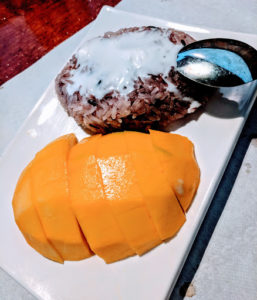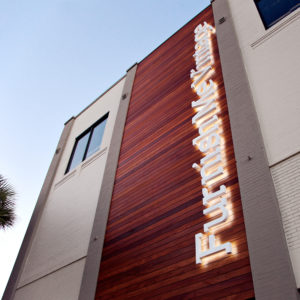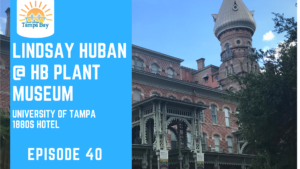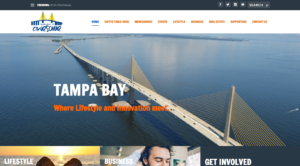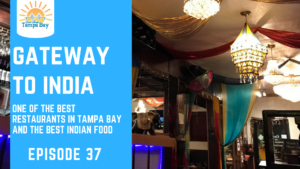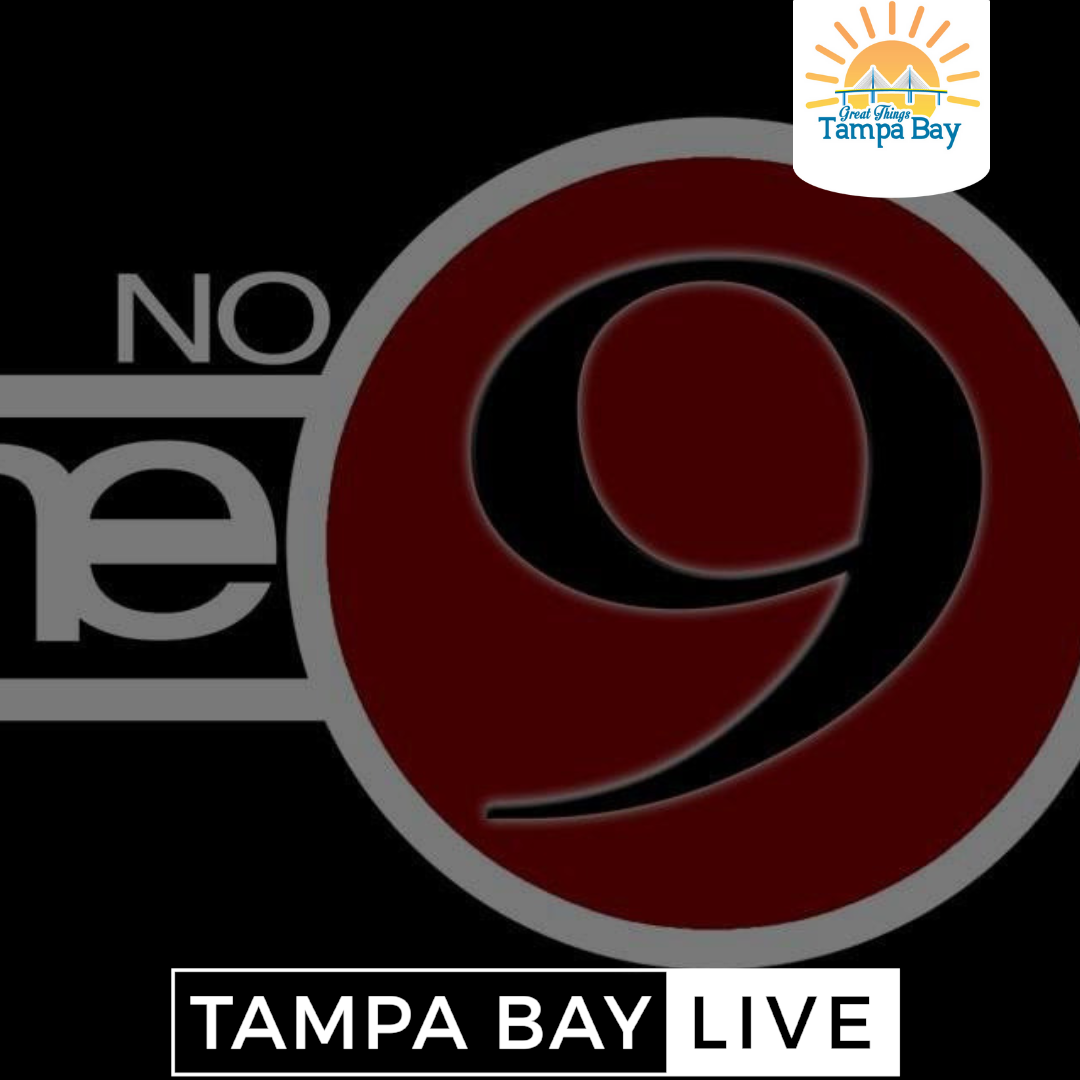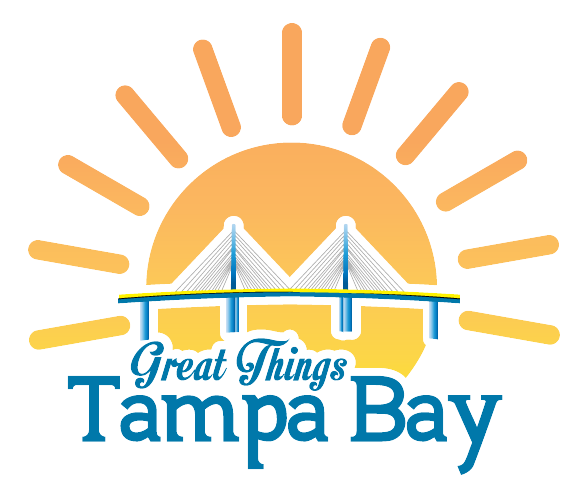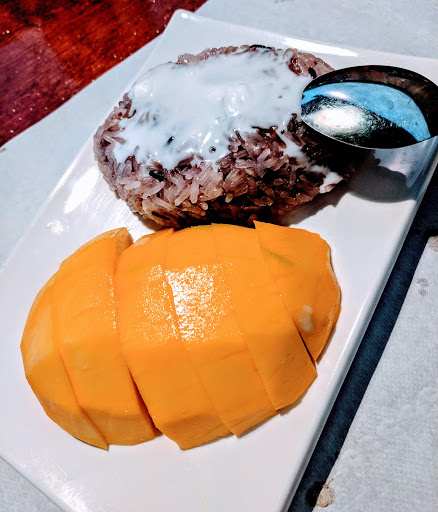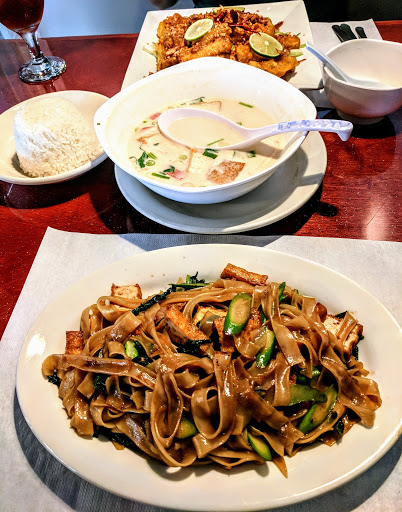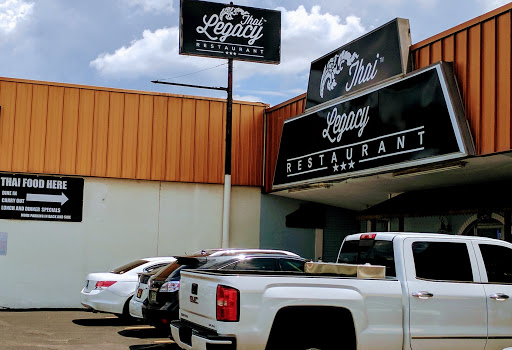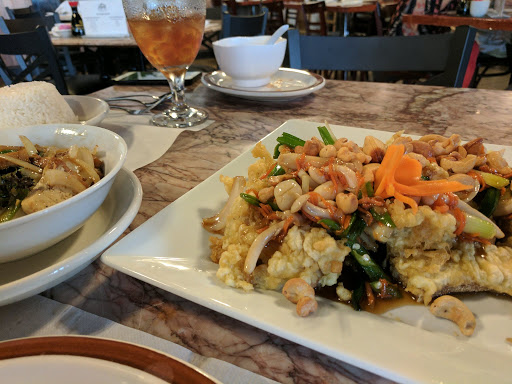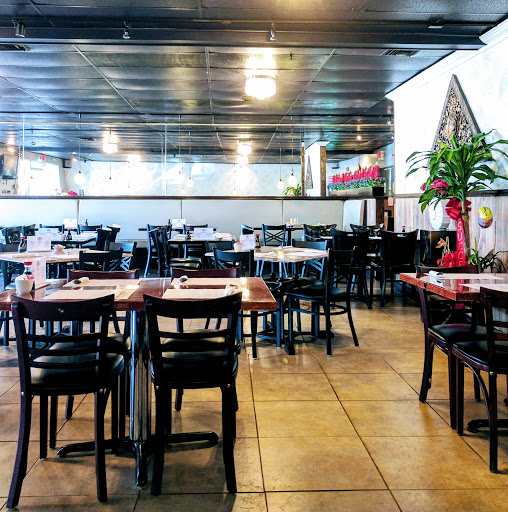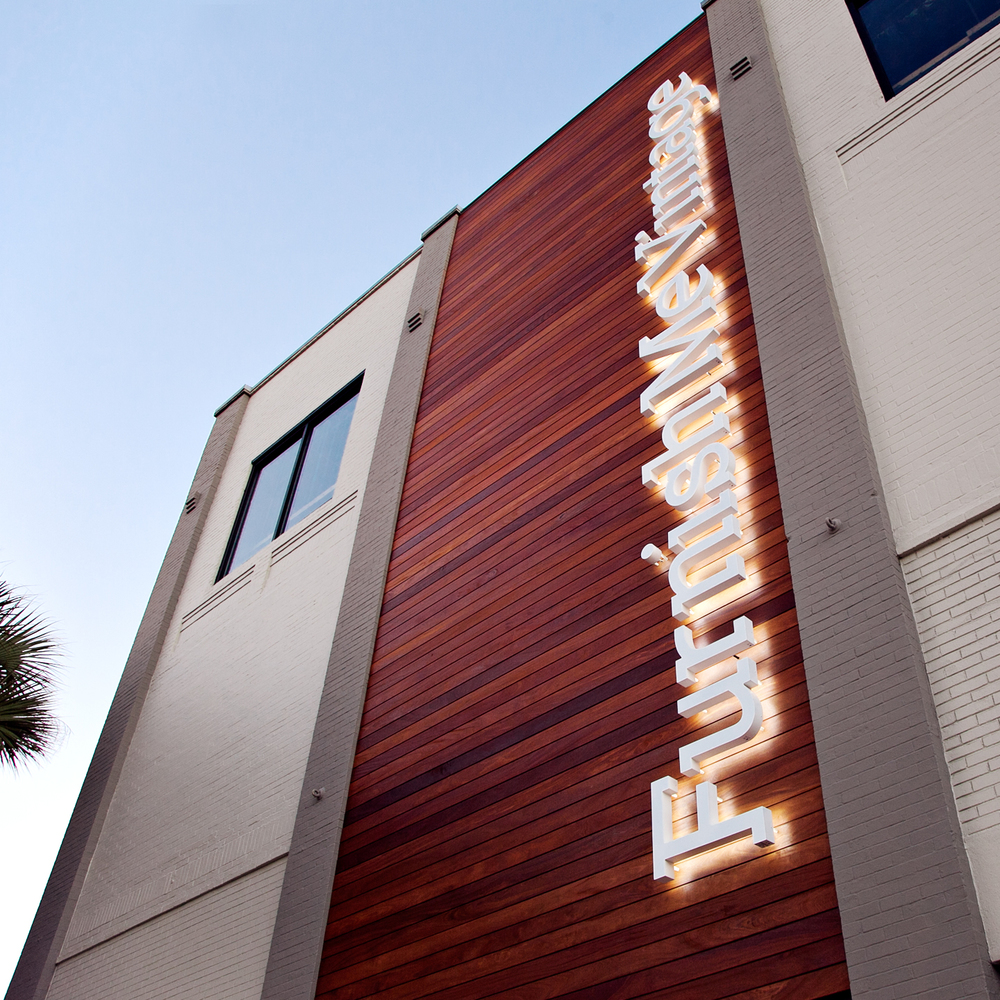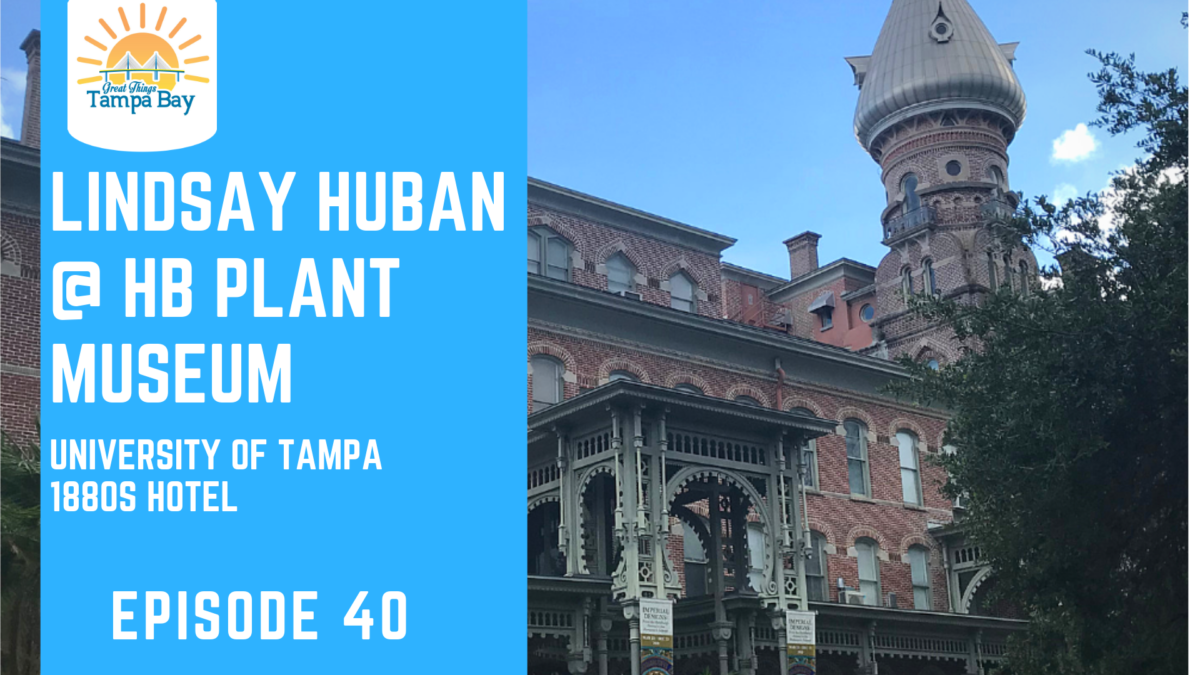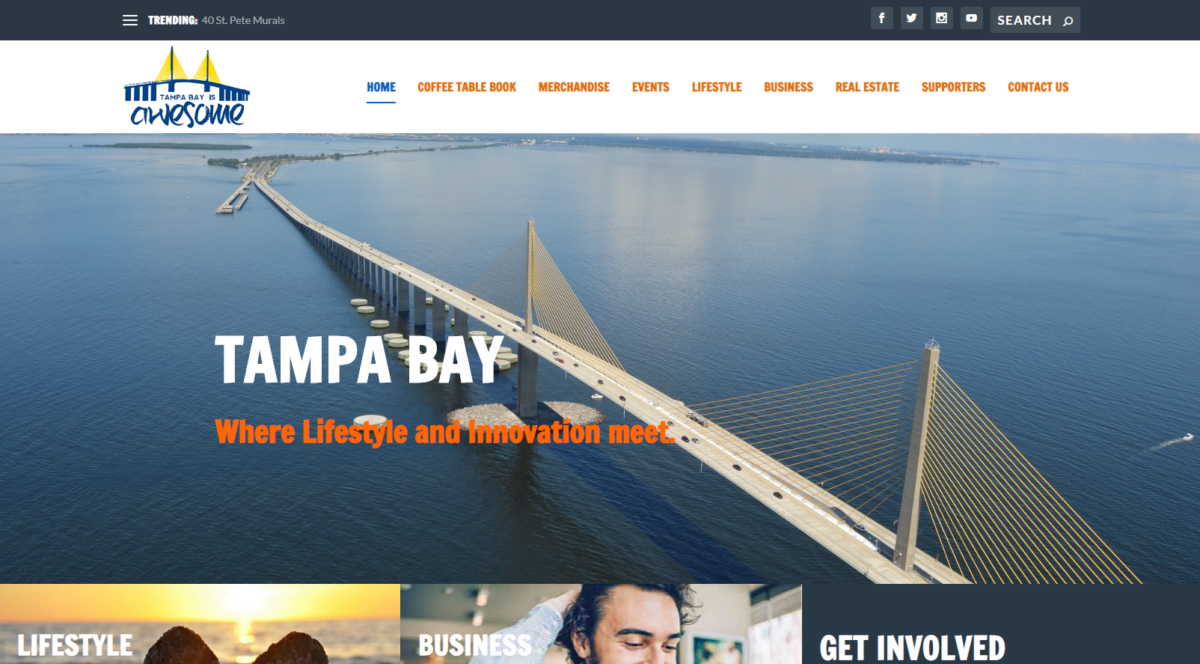Kyle: Hey everybody. This is Kyle Sasser here with the “Great Things Tampa Bay.” And today, I am at the lovely Henry Plant Museum located on the campus of the University of Tampa. And I’m here with a super smart museum lady, and I’ll let her introduce herself and give her credentials and all that good stuff.
Lindsay: Hi, everyone. My name is Lindsay Huban. I’m the museum relations manager here. So I’m happy to talk about the museum and all the great things we do.
Kyle: So we’re here in the office. We’re gonna do a little bit of questions back forth and then we’re gonna kind of go walk around the hotel a little bit. Let’s start off, give us the general overview of this building where we’re at, how old it is?
Lindsay: This building was originally the Tampa Bay hotel. It opened in 1891 and it was built by Henry Plant who built the railroad into Tampa. Now, to give you a little bit of context, before Henry Plant built a railroad here there really was no Tampa. There were 700 residents, it was a fishing village. Henry Plant built a railroad then decides to build a luxury hotel and the city just blossoms. There were 15,000 people just a couple of years later.
So what we have now is everything that’s left of the original artwork and furniture from the hotel. It’s really amazing that it’s all in its original location. You don’t find that anywhere else. So we are a museum of the hotel. We’re the oldest Museum in the city. We’ve been open since 1933.
Kyle: Okay. I didn’t know you all had been opened that long.
Lindsay: Yeah, we originally opened as the Tampa Municipal Museum and we had some interesting collections. There were some works progress, administration projects that were done at the building, the University of Tampa moved in, and then in 1974, we became the Henry Plant Museum.
Kyle: So we’re in this lovely room. What was this room originally and just kind of describe what we’re looking at in here?
Lindsay: Well, we are in what was a hotel room. So the nicest hotel rooms were on the first floor. The ceilings are 14 feet high on this floor so it’s a pretty nice space. We’ve got some big windows, just about every room had its own fireplace. And this room, in particular, would have been a multi-room suite.
So when you look around, you see a bunch of doors, we have our own bathroom, that’s now my co-workers office. There’s a little hallway where archives are kept leading over to our retired director’s office. So we use every space in the museum.
Kyle: And this room is absolutely gorgeous. It’s like the doors are innately curved and those are all original?
Lindsay: Yeah, actually, on the doors, there was originally silk flocked wallpaper, and in a failed attempt to preserve it, they lacquered over it so it looks kind of dark and brown and you can still see the pattern, but originally, it was yellow silk with gold threads running through it, would have just been gorgeous.
Kyle: Yeah. And I’m like, I’m looking at it right now and I thought it was like sort of like curved or burned in there, but, yeah, okay, that makes a lot more sense. All right. And then, so tell us some of the big features about this hotel, like what sets it apart from other hotels of that era and also so far as Tampa’s skyline goes.
Lindsay: Well, people ask me where I work and I say, “The Henry Plant Museum,” and they go, “Where’s that?” And I say, “Oh, it’s the University of Tampa.” “Well, where’s that?” And I say “The big red brick building with the silver domes on top,” and everybody goes, “Oh yeah, that one.”
So this is the building that we’re talking about. This was the first building in the state to be completely electrified. We have one of the early elevators in the city. Every room had its own telephone which was fantastic for calling the front desk and telling them to bring a piano to your room, but not so good for anything else because no one else had a phone.
Kyle: Was that a common request?
Lindsay: There was an orchestra that played at the hotel every evening and the advertisements state that if you don’t wanna listen to the orchestra, the porters will bring a piano to your room for you.
Kyle: Plant was a salesman, right?
Lindsay: Absolutely. This was very much a luxury hotel. You know, it took you four days to get here by train from New York City. So you weren’t coming for a weekend, you were coming for several months and so you were wealthy if you were saying here at the hotel.
Kyle: Okay, so tell us a little bit… So we talked about the domes on top. What’s the actual technical name for those? How are they made, and is the top…is that still gold?
Lindsay: So that’s an interesting question. There are 13 structures on the roof of the building. There are three domes, four finials, and six minarets. So the minarets are the ones that are the tallest, they are not actually gold. The original metal was tin that was painted over. They have all since been rebuilt and they’re currently stainless steel because it’s assumed that if Henry Plant had had access to stainless steel, that’s what he would have used for these.
Now the minarets actually were painted gold in the early ’80s for the Golden Jubilee of the University of Tampa. But that gold paint didn’t last very long. And so it didn’t look so good after about six months, so they’ve gone back to the original silver color.
Kyle: And the moons on top, were those gold at one point or?
Lindsay: They were not ever made of gold, unfortunately. We get a lot of questions about them. They’re just something to make the building look exotic.
Kyle: They lied to me. When I was here in 1995, they told me they were gold.
Lindsay: Well, I can tell you this, around the top of the baseboard in the grand salon, which is one of the giant ballrooms here, all the way around the room, this enormous room, the top of the baseboard had a layer of 23 and a half carat gold on the baseboard of a hotel. I mean, talk about conspicuous consumption.
Kyle: And that’s a big room. I’ve been in that one. That one’s big enough and amazing. Do you all still do weddings and stuff there or?
Lindsay: Yeah, absolutely. We have three ballrooms and they’re all used regularly.
Kyle: So, obviously, it’s not a hotel anymore. So like what your…did it stop, like… Bring us from luxury hotel in the early 1900s through to present day, like how did we get here?
Lindsay: So Henry Plant dies in 1899 and his heirs sort of fight over his empire, and the city of Tampa buys the hotel and 150 acres of grounds in 1904 and 1905. I should mention Henry Plant spent $2.5 million to build this building and that’s in 1891, an incredible amount of money. City of Tampa buys it for $125,000, so they got quite a steal.
So the city buys the building, they continue to run it as a hotel until the early 1930s. But by that time, we’re in the midst of the Great Depression, nobody has any money to come to Florida and stay at a luxury hotel. So the building closes. And there were a couple…there was about a year where it just sort of sat vacant, and the city wasn’t sure what to do with it.
The University of Tampa was founded in 1931. And they were operating out of a high school gymnasium, they needed a permanent home. So the city, they said, “Hey, we’ve got this great building, it’s sitting empty. University, would you like to use it?” So the university has been here with the museum ever since.
Kyle: Yeah, and I would think this is a little bit more prestigious than the gymnasium University.
Lindsay: Yeah, you know, when you’re trying to build the university and build a nice reputation to go with it, this building is gonna help with that.
Kyle: So obviously, the city bought this for $125,000 and it cost $2 million to build, but what sort of condition has this hotel been in over the years?
Lindsay: A lot of different conditions over the years. There have been some dark days and there have been some golden times. This is a historic building. It’s on the National Register so it can’t be torn down. But, you know, it’s made of brick, the cement has a lot of sand and seashells in it. So there are some problems that crop up from time to time and we’re a really old building, you know, pipes break, water gets in the walls, you know what happens next.
But the university does a great job maintaining the building and we’re very lucky to still have it. Actually, a lot of the windows when you look around still have the original glass in them.
Kyle: Okay, so that’s pretty impressive. So the bricks, are the bricks from here or were they brought in from…uh oh. I might have stumped her.
Lindsay: My understanding is that the bricks came from several different locations, but I can tell you to distract you from bricks that some of the steel cable and the steel framework for the building actually came from the Brooklyn Bridge.
Kyle: Interesting. Interesting. Well, so the reason I asked on the brick was whenever we were in Mount Dora, which was one of the first tourist destinations in…basically, the railroad came down through Jacksonville, Mount Dora was kind of the first tourist stop there. The older buildings downtown were built with mostly local brick. And the problem that they have with the local brick there is it’s very porous.
Lindsay: Very [inaudible 00:08:21].
Kyle: And so…yeah. So, if it’s on the sun side, it’s fine but if it’s on the shadow side, so if it’s on the north side of the house, the water just gets in there and basically just breaks it all apart. So, I’m sorry, that was my own personal nerd out. So the university moves in, in like what year?
Lindsay: ’33.
Kyle: Right. So 1933 the University moves in. Obviously, they have grown over the years. Do you know how many students are currently attending here, and also, kind of like what the goals are going forward for both the school and the museum?
Lindsay: Well, the school actually has a great reputation now. My understanding is that they have close to 9,000 students, which is incredible. They’re always doing construction on campus, and always really trying to better the university. They’ve got some great graduate programs. So they do a really fantastic job.
Our goals for the museum, our big one is really to raise the profile of Henry Plant. So many people in the area will hear them say, “Oh, I’ve lived here for 30 years and I’ve never come to the museum before, who’s Henry Plant?” We want to correct that. Next year will be Henry’s…would have been Henry’s 200th birthday. So it’s gonna be kind of a year of Henry Plant and we want everyone in Tampa Bay to know his name and know his importance to the city.
Kyle: So I’ve got a little quiz for you here. What town is named after Henry Plant?
Lindsay: Plant City.
Kyle: All right, that was very challenging, I know.
Lindsay: No. I actually didn’t know that myself until… I grew up in St. Pete and I thought it was named for Strawberry Plants.
Kyle: It’s a good guess, it’s a good guess. But basically anything that’s named like Flagler and Plant is obviously going to have a early railroad connotation from the 1900s. And then I actually just learned that it was Plants’ and not demons, but they built a railroad spur all the way over to St. Petersburg, because St. Petersburg was nothing for like 50 years after Tampa, and it wasn’t until the 1900s and they built that railroad spur that St. Pete actually became something, so interesting stuff. What’s one thing you wish everyone knew about Henry Plant?
Lindsay: On the spot. One thing that I wish everyone knew about Henry Plant is that the city of Tampa would not exist without him, quite literally. They had voted to unincorporate and stop being a city in the mid-1800s and it wasn’t until the area leaders were trying to woo Henry Plant and get him to build the rail line here that they reincorporated and became a city again.
And if you look at the manhole covers around the city of Tampa, there’s a ship on them. That is one of Henry Plant’s steamships. So I wish everyone knew that. Henry Plant is everywhere, you just got to look.
Kyle: Yeah, awesome, awesome. Yeah, because before the railway got here, there was probably maybe like the one trail that goes out like 301 and that’s pretty much it, otherwise you had to get here by ship. So let’s talk about Plant the man for a second here because I honestly, I don’t know much about like his history and how he was. I’ve read a…like, Rockefeller obviously, read about him. Flagler a little bit, mainly like his, you know, the Key West Bridge and all that stuff.
Lindsay: [inaudible 00:11:27] were good friends.
Kyle: Yes. So all these guys hung out during that time and they were rivals and cohorts in many ways. So, Plant, was he a robber baron, was he more like benevolent?
Lindsay: Henry Plant was definitely benevolent. He cared a lot about his employees. I can give you some great examples of that. He actually…so he was this railroad tycoon and he also had hotels and steamships, but when they were building his rail lines, he actually had a hospital car that would be at the end of the tracks so that anyone who was injured could get medical treatment right away.
He offered health insurance to his employees. This is the 1870s and 1880s and he’s offering health insurance. Henry Plant even…there’s a little town in Georgia, and I wish I could remember the name of it, that was started because his African-American employees did not have safe lodging close to the work site. And so he bought a bunch of land and founded this little town so that his employees could have a safe place to live.
Kyle: Maybe it’s called Plant City, Georgia.
Lindsay: It is not, I cannot remember the name of it, but he cared very much for his employees. And he passed that sense of generosity and responsibility and caring for others onto his son, Morton Plant, who became a great philanthropist and is well-known throughout the Northeast for that. And actually, Morton Plant Hospital in Clearwater is named for Henry Plant’s son, so he was a good guy, very much so.
Kyle: That’s good. So definitely a step above Rockefeller in all that.
Lindsay: Yeah, yeah, I think we can safely say that.
Kyle: No offense to the Rockefellers out there, but yeah. All right, so we’re gonna start our, I guess we can call this the walking tour.
Lindsay: Sound good to me.
Kyle: So, if we’re still here in the office and look around here, we have the beautiful windows and the doors, but up on the wall here there’s a red lion thing in a frame. So what’s that all about?
Lindsay: Well, actually, that’s a piece of the original carpet from the Tampa Bay Hotel. Carpet was not all that common simply because there weren’t vacuum cleaners, but this carpet, Henry Plant bought something ridiculous, 4,000 yards or something like that at a British auction house.
And the story goes that Queen Victoria commissioned this carpet, beautiful red carpet with a rampant lion on it, for Buckingham Palace and then she changed her mind and said, “No, people aren’t gonna walk on this.” Went to an auction house and Henry Plant picked it up.
Kyle: So thanks for the great carpet Victoria, it’s beautiful.
Lindsay: We have a larger piece on display in one of our rooms that I can show you as well.
Kyle: Yeah, cool. Well, so let’s talk a little bit about the museum. So how many people work here, what times are ya’ll open?
Lindsay: We’re open from 10:00 to 5:00, Tuesday through Saturday and 12:00 to 5:00 on Sundays. We have 7 full-time staff and 2 part-time staff and then we have 90 volunteers. So we’re always looking for more volunteers if anyone wants to get involved with the museum.
Kyle: Wow. Okay, so what sort of skill set does a volunteer need?
Lindsay: Enthusiasm, you should like people and wanna learn more about Henry Plant and the history of this building.
Kyle: And the willingness to volunteer.
Lindsay: Yeah, willingness to volunteer is pretty important too.
Kyle: All right, cool. And so, if they wanted to volunteer, where would they go?
Lindsay: We have three main positions for volunteers. One is a docent, so you’re actually leading guided tours of the museum, that’s a lot of fun. And the other two are at our front desk and our museum store. Those are great positions for somebody who wants a, you know, regular once-a-week position, high school students looking for those bright futures hours, anything like that.
Kyle: Is that what Al’s friendly face was doing?
Lindsay: Yes. Al Miller has been volunteering at our front desk for over 20 years.
Kyle: Whoa. All right, so I probably I might have seen him back in the ’90s when I was last year.
Lindsay: It is entirely possible. Actually, our curator has been here for 35 years so you might have gotten a tour from her.
Kyle: Yeah, might have, might have. All right, so let’s walk around, I guess?
Lindsay: All right, we are…actually, let’s come down this hallway. So we’re gonna go down this hallway. The space we’re gonna go into first, since we’re a museum of a hotel, we’re gonna go check out what a hotel suite would have looked like if you were a guest here.
Kyle: Cool. So we’re going down the hallway. So what’s this design called that we’re seeing all over the place?
Lindsay: That’s a keyhole and we have them everywhere. If we go take a look at the original elevator, there are a tiny little key holes curved into the wood of the elevator. And the doorway that we walked through, if we were to close that door and lock, it if you look down at the other end of the hall, we have our own private entrance to the hotel suite, just one of many signs that we’re in a luxury hotel.
Kyle: Yeah, that’s fancy. So all of this would have been one?
Lindsay: Yeah. So this is a three-room suite or a parlor suite. It would have cost about $5 a night. To put that into perspective, somebody working here like a groundskeeper or the head waiter would have been earning 40 or 60 cents per day. So we’re talking two weeks’ pay for one night in there.
Kyle: Yikes. Sorry, so that would be probably like $5,000, $6,000, something like that?
Lindsay: Quite a lot of money, more money than I could afford, for sure.
Kyle: Woo, a night.
Lindsay: So as we come down the hallway, the first room we’re gonna come to on the left is the music room because what hotel suite is complete without a music room?
Kyle: They had one at the Sheraton I stayed in.
Lindsay: We have a harp in here, we have a piano in here. And like I was telling you earlier, if you didn’t wanna listen to the hotel orchestra in the evenings, call the porter and they’ll bring you a piano so you can play the piano in your room. And if you don’t know how to play the piano, the porter will stay and perform for you, it’s no problem.
Kyle: Very nice, very nice. So who would be working here doing that sort of stuff?
Lindsay: Who would be working here? Actually, a lot of the staff worked at summer resorts in the north and then would come down here to the winter resorts for the winter. So they would follow sort of the tourists.
Kyle: The original snowbirds.
Lindsay: Yeah, yeah, pretty much, yeah.
Kyle: No offense, no offense to Northerners.
Lindsay: No.
Kyle: This is beautiful. So we’re looking in the room here. There’s a stand-up piano over here in the corner. It’s got a music book on there that says “Tampa’s two steps.” Have you heard this piece of music?
Lindsay: I have not heard the “Tampa two-step.” There’s another one called the “Tampa Bay hotel gallop” that I would love to hear some day too.
Kyle: Some choice pieces of music. There’s a harp and another fireplace…stop, fireplaces, it’s Florida.
Lindsay: Well, this was a winter resort that was opened December through April and it would get a little chilly. There were a couple of years that they actually had snow and it killed a lot of the exotic plants on the grounds. So if it was cold, you had your own fireplace, if it was warm in the evenings as you’ll see when we get to the bedroom, there are windows all the way around the bed so you can open them and get cross breezes at night.
Kyle: Yeah, nice, nice. And also, over there on the table, it looks like a Edison cylinder?
Lindsay: Yeah. Thomas Edison was actually one of the guests here at the Tampa Bay hotel. He stayed here with his wife, Mina, and they actually were featured in our Victorian Christmas Stroll Last year. We had a room dedicated to them.
Kyle: Very nice, very nice. And those that don’t know, Thomas Edison actually had a house and a small lab down in…
Lindsay: Fort Myers, Fort Myers area.
Kyle: Yes, it’s in Fort Myers, just before you get there. When I was there, lots and lots of angel trumpets on the property. So, you know, he might have been using some hallucinogens to spur the imagination a little bit.
Lindsay: Perfectly in keeping with the culture of the day, I’m sure.
Kyle: Yeah, you know, they had like Valium and cokes or something like that back then. Wow, okay.
Lindsay: Yeah. So we have now moved into the bedroom of the parlor suite. And if you picture the building, we have what look like the towers on the corners of the building, the bed is located directly underneath one of those minarets in the corner.
So you got the windows all the way around it. You actually have your own closet, which was a rarity, you have your own bathroom, another rarity in the 1890s. We talked about Flagler a little bit, there’s a great story that when the Tampa Bay hotel opened, Henry Plant invited Henry Flagler, sent him a telegram and said, “Come to the opening.”
Flagler replied and said, “Well, how am I supposed to know where to go? There’s nothing in Tampa.” Plant replies back and says, “Well, just follow the crowds.” So that’s Plant’s answer to the Ponce de Leon.
Kyle: A little bit of banter back and forth.
Lindsay: Yes, yes. Business rivals, but definitely good friends.
Kyle: Well, it’s not like there was anything Flagler, Flagler beach or the west coast to that point in time either, really.
Lindsay: That’s very true. A lot of that came shortly after.
Kyle: So this is beautiful. So again, we got huge 14-foot ceilings. The bed is literally like in the round turret section underneath the minaret. There’s a gorgeous Millwork… I don’t even know if that’s mill… I don’t even know what you’d call that.
Lindsay: It’s plaster. Oh…artisanship.
Kyle: Absolutely amazing. Yeah. Well, permission, I’m gonna take a picture of that and put it in the show notes? So…yeah.
Lindsay: No, of course. Yes.
Kyle: Because that’s crazy.
Lindsay: One thing, it’s kind of cloudy and it’s gonna rain outside right now so it’s getting a little dark in the museum because we have authentic lighting in here. We have chosen to recreate the original lights from the Tampa Bay Hotel.
Now, I said this building was the first in the state to be completely electrified, the newspapers describe it as being ablaze in light, read a book any time of day. It is very dim in here right now and I would not wanna try to read a book.
Kyle: Yeah, it’s very…it’s very dusky.
Lindsay: But electricity was so new. This was a way to show off the technological advancements of the building and that Henry Plant had enough money to build a building like this with electricity.
Kyle: And honestly, this would probably be like, you know, 400 candles lit in here.
Lindsay: Yeah, probably something like that. We have…let me see if I can get this name right there, replica Edison carbon filament bulbs that we have in all the light fixtures in here.
Kyle: Yeah, very cool. I noticed some when I was walking in, some of the fixtures coming in. So, yeah, this is beautiful. My wife would love this.
Lindsay: Well, you should bring her sometime. So we have one room left of our three-room suite to see. So we are now in the parlor or the sitting room. This is sometimes called the library as well. There were big public spaces of the Tampa Bay Hotel, but if you were getting a little overwhelmed, you could come sit in your own private space, maybe write a letter home. We have an antique typewriter on display that I usually call a primitive laptop because it’s in a carrying case.
So you could write a letter anywhere you needed to. And again, you can see some of the beautiful wallpaper on the doors. We have original Wedgwood vases on display. I mean, really spared no expense is the only phrase you can use to describe it.
Kyle: Yeah, this is pretty, pretty impressive.
Lindsay: Yeah. And we’re a lifestyle museum so we want you to feel like you’re stepping back in time. And I think in the parlor suite, we do a great job of that.
Kyle: Yes, indeed. And I’m a bit of the typewriter nerd too. Just trying to see if I could see like what model of this is. So it’s actually built into this case, which is pretty interesting. And it’s definitely older than like the Underwood 3s and 5s that you’d normally see in like the 1910s.
Lindsay: Oh, yeah. This dates to the late 1800s. This is an old typewriter.
Kyle: Yeah, it definitely…it looks more like a cotton gin than a typewriter really, to me, at least. Like it’s very…like cast iron parts all around it. Very cool. I like it, I like it. Book me up for a week.
Lindsay: We hear that a lot.
Kyle: All right, moving on.
Lindsay: We do have a rotating exhibit space. I don’t know if you’d wanna see that or not. It’s up through December.
Kyle: Yeah, sure.
Lindsay: So we can take a look in there. I’m trying to think, this is an interesting piece, this chair here on the right hand side. So this chair is actually called a Victorian courting chair, or a tête-à-tête so that a young man and a young lady could sit and have a conversation here without a chaperone because the chair is its own chaperone.
The young man and the young lady sit facing separate directions, facing opposite directions, and then the wooden armrest goes in between them so they can only get in so much trouble here.
Kyle: So looking at the chair, it’s basically kind of an S-shape facing opposite directions, so you can kind of lean over on your sweetie, but that’s about it.
Lindsay: Yeah, nothing too improper for the Victorians.
Kyle: Yeah, so we’re looking at this room. There’s a lot of…I mean, I would call them formal sitting chairs, but they probably just called them sitting chairs back then?
Lindsay: Yeah, something like that. We have a lot of the furniture left from the ballrooms and the grand salon was sort of like the living room of the Tampa Bay Hotel. The photos we have show it full of these gorgeous chairs that we would be afraid to sit in today, but these were just where you would go, where you would hang out in the afternoon.
Kyle: Yeah, this is definitely something that my grandmother would have shooed me off of. And then there’s like a magnifying thing here for…?
Lindsay: Yeah, that’s a stereoscope viewer. So we have the stereo cards that have two images that are just slightly different. When you look at them through the lenses, it looks like a 3D image.
Kyle: So it’s like a old-school View-Master, basically?
Lindsay: Very much so, yeah.
Kyle: Very cool, very cool. So what other… So besides Teddy Roosevelt, what other famous guests did we have here?
Lindsay: Babe Ruth was a guest at the hotel. He actually hit the longest home run of his career here. John Philip Sousa, the famous band leader, Sarah Bernhardt, the famous actress, Anna Pavlova, Russian ballerina, Booker T. Washington spoke here, pretty much anybody and everybody who was famous at the time. Nellie Melba for whom Melba Toast is named was a guest here.
Kyle: This was the place to be then?
Lindsay: Yeah, absolutely. This was the big resort on the west coast of Florida.
Kyle: So not even like Naples… Like Naples, Venice, those were probably just dreams still at that point.
Lindsay: Yeah, absolutely. Henry Plant had seven hotels throughout the State of Florida. This one was the crown jewel for sure.
Kyle: And it’s definitely gorgeous. So we’re just kind of walking down the hallway here, huge tapestries, big sculptures.
Lindsay: Yeah. Actually, the first piece of public art in the city of Tampa was here on the grounds of the hotel. When you make your way up into the museum, you see a sculpture of two dogs, first piece of public art in the City of Tampa and it was sculpted by a woman.
Kyle: Interesting, very cool, very cool.
Lindsay: This room over here is our most authentic space.
Kyle: So we’re going into the authentic space.
Lindsay: This is called the Writing and Reading room. This is probably my favorite room in the museum because it is our most authentic space in the museum. And what I mean by that is, we have a couple black and white photos on display of this room in 1890s, you really can’t tell a difference aside from ropes on the chairs to keep people from sitting on them it looks the same.
Kyle: How many people have tried to sit in these chairs?
Lindsay: More than I would like to count.
Kyle: Don’t sit in the chairs, people.
Lindsay: So when you look at the photo, there’s really no differences down to their two small portraits of dogs hanging on the wall they’re still hanging in the same place.
Kyle: I see it and it still kind of smells like pipe tobacco and cigars in here.
Lindsay: Well, actually, there’s a reason that it smells a little bit like tobacco. A couple of years ago, during our Victorian Christmas Stroll, we had a Christmas in Cuba tree and we dried real tobacco leaves to decorate the trees.
Kyle: And it still lingers.
Lindsay: Like I said, authentic.
Kyle: Yeah, very cool, very cool. So this is where people would come and gather and…
Lindsay: This was basically the business center for the hotel. So if you were coming down for the season and you were a businessman from the north, you couldn’t just abandon your business the whole time. So you might write letters home here, read the newspapers, send your telegraph’ and telegrams and keep up with everything in here. This is primarily a space for gentlemen, which is evidenced by the spittoons that are on the floor.
Kyle: And they’re still there.
Lindsay: They sure are. And actually, the doorway at the end of this room leads downstairs to the resceller [SP], which was originally a bar and a barbershop and there were billiards tables down there so kind of a man cave for the 1890s.
Kyle: Very cool. Do they still serve beer down there?
Lindsay: Unfortunately, they do not. But they do serve coffee and sandwiches. The students are disappointed too.
Kyle: Yeah, I’m sure, I’m sure. So this is definitely, this is very cool, very cool. But yeah, with the lighting, it’s not ablaze. This would not pass code currently for ample lighting.
Lindsay: No, no, not so much.
Kyle: But absolutely beautiful.
Lindsay: Yeah. And actually, we had a paint analysis done in this room and went through, I don’t know, 14, 17 layers of paint to determine the original paint color, and it’s this kind of pale yellowish color, kind of interesting for a gentleman space.
Kyle: Yeah, amazing. It’s good stuff, it’s good stuff.
Lindsay: So we have a rotating exhibit up right now, if you’d like to see that.
Kyle: Yeah, let’s take a look.
Lindsay: It’s much more brightly lit.
Kyle: Ah yes, track… Is this the original track lighting?
Lindsay: Oh yeah, dating back to the 1990s. So we’re now standing in our rotating exhibit space. So that exhibit in here right now is called Imperial Designs: From the Habsburg’s Herend to the Romanov’s Fabergé. This is just an incredible collection of porcelain and glass and pieces from the Imperial dynasties of Europe in the late 1800s, early 1900s.
So we have things here that belong to the Habsburg’s of Austria, and the Romanovs before the Russian Revolution. So the last emperors, the last Zurs [SP], this is the things that they would be using.
Kyle: Yeah, and they are beautiful, very ornate.
Lindsay: Yeah, we have Fabergé on display in here, we have a beautiful collection of Russian eggs that were often given as Christmas presents and Easter presents. And we have this exhibit up now because people who would have been staying at the Tampa Bay hotel often would have been doing what was called the Grand Tour and going to see these Imperial courts. So this is very similar to what they would have been seeing on their travels.
Kyle: Yeah, and it’s amazing. Very nice.
Lindsay: Yeah, all alone from one collector who lives in Tampa.
Kyle: Wow. Yeah, that’s impressive.
Lindsay: Yeah, yeah. For anyone who’s looking for the perfect gift, we have a great museum store that people should come take advantage of. And we do some great programs where we’re the best placed to bring your out-of-town-guests when they’re coming to visit you.
Kyle: And yeah, it’s just a great place just to kind of walk around. So there’s the actual museum and hotel part here and then there’s like a park outside by the water side.
Lindsay: Yeah, Plant Park is actually right out in front of the building. It’s a public park, it’s a great place to walk around. There’s also a cell phone tour that you can do out in the park to get some more information and it was all part of the original grounds, so it’s been restored. There’s some trees out there that have been there well before the hotel was built and hopefully, it will be here for the next 100 years, at least.
Kyle: Yeah. So there was river rock, there was the Plant Park.
Lindsay: Exactly, before river rock, Plant Park, for sure. So actually on the grounds of the hotel, there was a racetrack, the state fairs were held here, the very first guest [inaudible 00:30:11] celebrations were here at the hotel, there was a casino that was a performing arts center. I mean, this was the center of Tampa.
Kyle: So it hasn’t always been just like the campus and then like all of the dorms and all that stuff back there?
Lindsay: Oh no, there were actually 21 buildings when the hotel was in service. It had its own power plant, there was the other casino that I mentioned that could seat 2,000 people, there was a racetrack, bicycle courses, hunting and fishing, a greenhouse, a boathouse, really…
Kyle: It was literally a resort instead of just…
Lindsay: Yeah, yeah. Think all-inclusive resort and you’ll get a little closer.
Kyle: The original Disney World.
Lindsay: We do call it the first Magic Kingdom.
Kyle: There you go. All right, so Lindsay, thank you so much.
Lindsay: My pleasure. This has been a lot of fun.
Kyle: So people that wanna come here and visit, how do you get here? Where should they park, when are you all open?
Lindsay: We are open Tuesday through Saturday 10:00 to 5:00, Sunday 12:00 to 5:00. You can get all the information at plantmuseum.com, and we have parking right out in front of the museum and a free garage as well, free parking downtown and yeah, come, check us out.
Kyle: All right. Thank you so much.
Lindsay: My pleasure.
